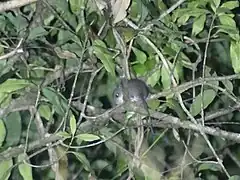| Pogonomys | |||
| Milne-Edwards, 1877[1] | |||
 Przedstawiciel rodzaju – myszarek kasztanowaty (P. macrourus) | |||
| Systematyka | |||
| Domena | |||
|---|---|---|---|
| Królestwo | |||
| Typ | |||
| Podtyp | |||
| Gromada | |||
| Podgromada | |||
| Infragromada | |||
| Rząd | |||
| Podrząd | |||
| Infrarząd | |||
| Nadrodzina | |||
| Rodzina | |||
| Podrodzina | |||
| Plemię | |||
| Rodzaj |
myszarek | ||
| Typ nomenklatoryczny | |||
|
Mus (Pogonomys) macrourus Milne-Edwards, 1877 | |||
| Synonimy | |||
|
| |||
| Gatunki | |||
| |||
Myszarek[5] (Pogonomys) – rodzaj ssaków z podrodziny myszy (Murinae) w obrębie rodziny myszowatych (Muridae).
Zasięg występowania
Rodzaj obejmuje gatunki występujące w Australii i na Nowej Gwinei[6][7][8].
Morfologia
Długość ciała (bez ogona) 92–205 mm, długość ogona 126–262 mm, długość ucha 11–17,5 mm, długość tylnej stopy 19,1–33 mm; masa ciała 28–158 g[7][9].
Systematyka
Rodzaj zdefiniował w 1877 roku francuski zoolog Alphonse Milne-Edwards na łamach Comptes rendus hebdomadaires des séances de l’Académie[1]. Na gatunek typowy Milne-Edwards wyznaczył (oznaczenie monotypowe) myszarka kasztanowatego (P. macrourus).
Etymologia
- Pogonomys: gr. πωγων pōgōn, πωγωνος pōgōnos ‘broda’; μυς mus, μυος muos ‘mysz’[10].
- Macropogonomys: gr. μακρος makros ‘długi’; rodzaj Pogonomys Milne-Edwards, 1877[4]. Typ nomenklatoryczny (oryginalne oznaczenie): Macropogonomys maxhoseri Hoser, 2020 (= Pogonomys macrourus Milne-Edwards, 1877).
Podział systematyczny
Rodzaj ten należy do australijskich i nowogwinejskich „starych endemitów”. Jest spokrewniony z rodzajami Anisomys, Chiruromys, Coccymys, Hyomys i przypuszczalnie Mallomys[8]. Do rodzaju należą następujące gatunki[11][9][6][5]:
Uwagi
Przypisy
- 1 2 A. Milne-Edwards. Note sur quelques Mammifères nouveaux provenant de la Nouvelle-Guinée. „Comptes rendus hebdomadaires des séances de l’Académie”. 85, s. 1081, 1877. (fr.).
- ↑ H. Kaiser, B.I. Crother, Ch.M.R. Kelly, L. Luiselli, M. O’Shea, H. Ota, P. Passos, W.D. Schleip & W. Wüster. Best practices: in the 21st century, taxonomic decisions in herpetology are acceptable only when supported by a body of evidence and published via peer-review. „Herpetological Review”. 44 (1), s. 8–23, 2013. (ang.).
- ↑ N. Upham, C. Burgin, J. Widness, M. Becker, C. Parker, S. Liphardt, I. Rochon & D. Huckaby: Pogonomys macrourus (Milne-Edwards, 1877). [w:] ASM Mammal Diversity Database (Version 1.11) [on-line]. American Society of Mammalogists. [dostęp 2023-10-11]. (ang.).
- 1 2 R.T. Hoser. An overdue break-up of the genus Pogonomys Milne-Edwards, 1877 (Mammalia: Muridae) into two genera and the formal naming of five long overlooked species. „Australasian Journal of Herpetology”. 49, s. 45, 2020. (ang.).
- 1 2 Nazwy polskie za: W. Cichocki, A. Ważna, J. Cichocki, E. Rajska-Jurgiel, A. Jasiński & W. Bogdanowicz: Polskie nazewnictwo ssaków świata. Warszawa: Muzeum i Instytut Zoologii PAN, 2015, s. 277. ISBN 978-83-88147-15-9. (pol. • ang.).
- 1 2 C.J. Burgin, D.E. Wilson, R.A. Mittermeier, A.B. Rylands, T.E. Lacher & W. Sechrest: Illustrated Checklist of the Mammals of the World. Cz. 1: Monotremata to Rodentia. Barcelona: Lynx Edicions, 2020, s. 492. ISBN 978-84-16728-34-3. (ang.).
- 1 2 Ch. Denys, P. Taylor & K. Aplin. Opisy gatunków Muridae: Ch. Denys, P. Taylor, C. Burgin, K. Aplin, P.-H. Fabre, R. Haslauer, J. Woinarski, B. Breed & J. Menzies: Family Muridae (True Mice and Rats, Gerbils and relatives). W: D.E. Wilson, R.A. Mittermeier & T.E. Lacher (redaktorzy): Handbook of the Mammals of the World. Cz. 7: Rodents II. Barcelona: Lynx Edicions, 2017, s. 706–708. ISBN 978-84-16728-04-6. (ang.).
- 1 2 D.E. Wilson & D.M. Reeder (redaktorzy): Genus Pogonomys. [w:] Mammal Species of the World. A Taxonomic and Geographic Reference (Wyd. 3) [on-line]. Johns Hopkins University Press, 2005. [dostęp 2020-12-09].
- 1 2 Class Mammalia. W: Lynx Nature Books: All the Mammals of the World. Barcelona: Lynx Edicions, 2023, s. 316. ISBN 978-84-16728-66-4. (ang.).
- ↑ T.S. Palmer. Index Generum Mammalium: a List of the Genera and Families of Mammals. „North American Fauna”. 23, s. 554, 1904. (ang.).
- ↑ N. Upham, C. Burgin, J. Widness, M. Becker, C. Parker, S. Liphardt, I. Rochon & D. Huckaby: Treeview of Mammalian Taxonomy Hierarchy. [w:] ASM Mammal Diversity Database (Version 1.11) [on-line]. American Society of Mammalogists. [dostęp 2023-10-11]. (ang.).